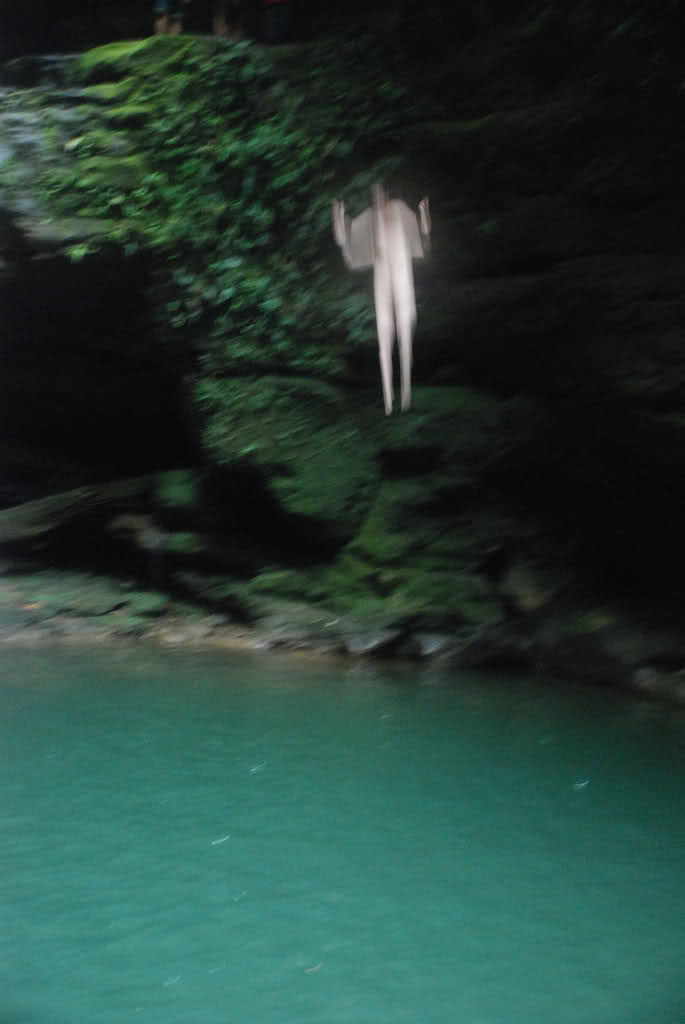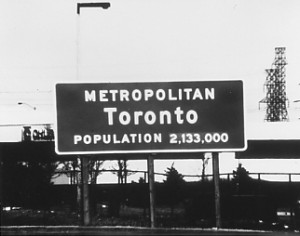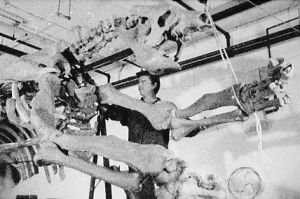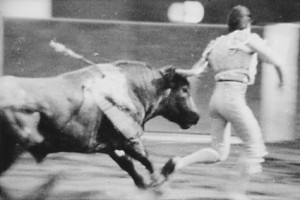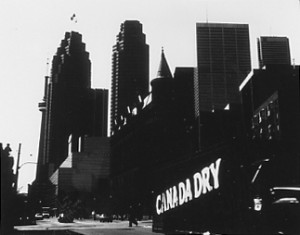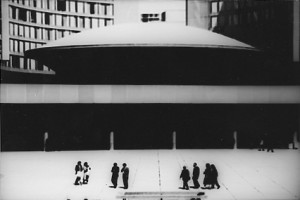Mexico 35 minutes, 16 mm, 1992
“In Mexico, experimental filmmakers Hoolboom and Steve Sanguedolce set out to dissect the travel bug. Hoolboom’s deadpan, incisive voice-over offers the viewer the air-tight experience of a Third World holiday, while images from an archaeological museum to a bullfight to an auto factory establish the dual contexts of tourism and Free Trade.” Toronto International Festival
“Mexico ruthlessly unmasks and dissects the assumptions and half-truths we tell ourselves about development and progress. Not so much a film as a series of live-action postcards, the images are sustained by an incisive voice-over. The tour ranges from an archeological museum to a car factory (‘a factory which produces only smoke’) to a hideously graphic bullfight, linking cultural colonialism to free trade. ‘Everything you touch turns into Toronto,’ Hoolboom says, and this vacation jaunt ends with the disquieting transformation of the Mexico City streets into the 401.” Josh Ramisch, Variety
“In Mexico, first prize winner at this year’s Oberhausen Short Film Festival, we are taken to Mexico City and back to Toronto in a timeless, beautifully filmed and paced journey through the ‘New World Order’ with images of bullfights, dinosaur graveyards, aquariums, tourists climbing the Aztec Pyramids and the belching smoke of a North American factory polluting the Mexican jungle.” Cordelia Swann, London Film Festival
“This high contrast, anti-travelogue benefits from a sharply ironic image track and a mordant voice-over that lends menace to the notion of direct address. Between the film’s title and its somewhat arch ‘erasure’ the subject shifts from Mexico to its Canuck observers.” ‘Top Ten Films of 1992’, Cameron Bailey, Now Magazine
“The jury felt the best experimental film would be the work which not only displayed a new way of looking through cinema but which also found something new at which to look. In this spirit the jury has awarded the prize for best experimental film to Mexico. Although its initial context is a languidly dystopic trip from Toronto to Mexico and back again, its true subject is power: the power inscribed in the unseeing gaze of the tourist, the power manifest in the recently signed North American Free Trade Agreement, under the auspices of which Mexican workers threaten to be divided up by American and Canadian corporations tired of living wages, labour unions and environmental regulations.” Oberhausen Jury
“When you travel through an unknown country with the aim of forgetting about where you come from, you’re bound to see the new places as willing reproductions of what you are trying to leave behind. Thus the lonely traveller in Mexico, escaping his hometown of Toronto, cannot but project the fundamental questions about life, death and history that trouble his mind upon this new environment solely within the context of his own background. What was supposed to become a touristic relief or the beginning of a new life turns into a lucid and sensitive analysis full of unfamiliar images, a compelling journey into his own state of mind.” Miryam van Lier, Visions du Reel
“Quintessentially cinematic, this filmed narrative by Hoolboom and Sanguedolce manipulates a series of disjointed images, edited to create an uninterrupted unity of shots. Pure visual poetry, it takes the viewer on a timeless voyage with images of an archaeological museum, a dinosaur cemetery, automobile factories and a bullfight, all recorded during a trip to Mexico. They serve to denounce the role played by cultural exoticism in value systems encouraging acculturation. Through a personal interpretation of memories, stories and experiences, the work attempts to demystify our desire for an elsewhere: exoticism, in a word. By examining social inequalities, it also seeks to unveil the half-truths and stereotypes that we retain with economic development and North American free trade.” (Fringe Dreams by Karl-Gilbert Murray, Festival of Films on Art Catalogue)
“If the travelogue can be understood as a form of autobiography, writing oneself through place, then the postcard may be a seen as a shorthand version of this process. However, when the form is paired down to a picture of a place that was never seen in the same way as it was imaged, and the text reduced to what fits on to the back of a 4″ x 5″ card, one is inclined to think of McLuhan’s dictum that the ‘medium is the message,’ and that the gesture of sending the postcard is more important than the message carried on its back. However, anything specific that could be said by the sender is rendered null and void by virtue of the fact that the postcard is always addressed, much like television, to ‘everybody and nobody at once’: having a great time, wish you were here.” Real Time and its Discontents: The De-realization of Temporality in Media Culture by Lee Rodney
Steve and I were drunk one night, sharing a tall boy of Jack Daniels like others share the blood of their saviour, before deciding we should cement our friendship with a drive. We pulled out the globe, spun it until latitudes became long, and pointed toward our destination: we were going to Mexico.We stopped along the way to interview strangers about love in front of Elvis’s Graceland, got hosed down in the drunk tank at New Orleans, and dodged armed banditos in the mountains south of Monterey. When we finally entered Mexico with its infinite supply of cheap tequila and speed, we were graced with a democracy of vision. Everything looked perfectly equal. Every object looked ready to jump in and take the place of its neighbour, as if we were watching a country that had magically attained the speed of television. We used our cameras the way supermodels deploy lipstick and eyeshadow, as part of our personalities, and quickly made doubles of everything we saw before hauling our image trophies back home. Once the hangover had passed we uncovered a toss of unconnected moments, and spent the next three years trying to give them shape. After our return, haunted by the old dreams of getting smaller, it’s as if we’d never wandered from home at all. As if the only thing that had ever left was our imagination.
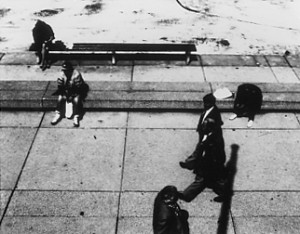
A short film about killing: Mike Hoolboom’s and Steve Sanguedolce’s Mexico by Veronika Rall (1992)
The film begins and leaves its spectators in the dark. Just a soft, male voice, which sounds like that of a fairy-tale-teller, who promises consolation and security to children who face uncanny sleep, uncanny darkness. The voice fascinates, pulls us into the film, and dictates its rhythm. But it doesn’t tell us soothing bed-time-stories: Like Sheherazade, Mike Hoolboom seems to want to save himself and us from a history and a presence, from the future of an impending death sentence. He talks about a flight, and that the past seems far too torturing in the presence — a history of flight, but then again, “why are the arms of airport buildings called terminals?”
“You have been here all along… ” — the film begins and ends at the same time, as if it never existed. The title repeats the gesture when it — unrepresentable typographically — prints two thick crossed bars over the letters, as if the naming of the goal of the flight would be a ‘too much.’ From the beginning, Mexico denies the images Hoolboom & Sanguedolce brought from their journey to this ‘no-image-land’: those of the young car-washers, the poor villages and booming towns, the vast cemeteries. The filmmakers have been to Mexico, but they pretend not to have seen anything. They feel like King Midas, because everything they touch (film) becomes Toronto, their home town. Like Midas, the conquistadors who came to South/Middle America in search of gold, their story is documented by the Museum of Invasions, which Mexico tells us about at the beginning. Today, Mexico is still marked by the greed of the north — by it’s accumulated treasures that even poor artists will profit from. This is what the filmmakers realized, and they subject their very own gesture of wealth & domination to relentless criticism.
But it is not gold, they’ve been looking for in Mexico. Not possessions and treasures, but loss, lack and forgetfulness brought them to a presumed no-man’s-land. And thus Mexico for them — every man his projection — becomes an uncanny landscape with a ghostlike topography, Mexico the seductive protocol of a repression. Nonetheless, the monster of the past seems omnipresent, the memory of media-cyberspace a totality: Grasshoppers, over dimensional cats, or cockroaches — which Hollywood bread in repulsion of the reality of the cold war — crowd Mexican TV screens; in its museums, dinosaurs awake to life out of piles of bones; relics remain, out of which the present creates a monstrous, imaginary past; living fish swim in the blue water of the aquariums — one fails to imagine it in the living waters of the Mexican gulf. It is as if the imagination of life is bound to fail due to the mummifications of the past.
Yet in one sequence of Hoolboom’s/Sanguedolce’s film life and the fascination for its images becomes an image, because the filmmakers record the work of death. This sequence stands nearly at the end of the film, yet with a duration of nearly 5 minutes, it takes much of its time, so my interpretation of it as a key-sequence may be pardoned. And as if the filmmakers hadn’t trusted their voyeurism on life, they provided its images with a mask. Thus, with a guarded gaze, they show us a fiesta, during which the torero is nearly killed by the animal, a horse too only barely escapes the same fate. But it is the suffering of the doomed creature that seems to have fascinated the filmmakers: Yet another spear is rammed into its back, to enforce the fateful aggression, the coup de grace is the demonstration of pure dilettantism: hereabouts, the scene would bring any animal protection activist to the barricades, if the fiesta hadn’t been banned already.
The work of death seems a disgusting butchery, the death of a living being endless. Again and again, the toro assembles his last forces, gets on his legs, until finally not the torero but a helping hand applies the deadly stroke, and the cleaning team can take over. Here is more at stake than the illustration of Cocteau’s definition of cinema: “to watch death at work”, and even Hoolboom’s voice has been silenced by the slaughter on screen. Even though the sequence doesn’t run synchronously but has been edited rhythmically, there’s for the first time no voice over, no music in the film. Here, the tension of the images seems to be strong enough, so strong, that the filmmakers feel the urge to distance not only themselves but the spectator too. This is, gently put, too bad. The film is, definitely, no classical documentary of a journey, but the critical attempt to — by the means of language and the negation of image — flee touristic exotism, but also to avoid one’s own affects. Yet the (“politically correct”) denial of such emotions deprives Mexico and its spectators of a reflexive power. Rather, like a mask, the distanciation maneuvers itself in front of our perception and inhibits what might have been exhibited: the intertwining of individual and cinematic projection. Instead of admitting the lure into scopophilia for the filmmakers and delivering it to the spectators as well, the film disavows the lure by the distanciation. The fiesta-sequence is the epiphany of Mexico: it denies the repressing force it might take to kill life, to mummify the present and repress the past, in the end: to distanciate oneself from passion & empathy. The film keeps its public off its neck. Piano passages, Christian chorals and electronic music guide the spectator/ listener over images and black film like a requiem over a burial. Sheherazade’s voice helps us to forget suffering and pain that had been in our minds briefly. And Sheherazade saved herself, the impending death sentence has been revoked. Yet we, the spectators, leave the movie with another sentence: “Nothing improves memory more than trying to forget.”
Travelling with Mike Hoolboom and Steve Sanguedolce by Niliema Karkhanis (1994)
Mike Hoolboom and Steve Sanguedolce, both Toronto-based filmmakers, offer a critique of colonialism and historical occupation in their film Mexico. Unlike a more traditionally fashioned Canadian documentary (such as the phenomenal work of Alanis Obomsawin), theirs is entirely devoid of key actors, actions and events. Mexico features a series of disjointed filmic snapshots, edited together, with a poetic voice-over from Hoolboom. It is a characterless, relational portrait of (you), a critical westerner’s journey through a NAFTA country.” Who am I here?” it asks.
Many of Hoolboom’s films are concerned with perversion, the body, death, illness and their driving nostalgias. Mexico reveals little about the subjective experiences of awry bodies; although the use of the second person in the voice-over introduces an element of physicality. Nostalgia underlies this text as an ever-present expression of movement and memory. This is an underground Canadian essay about regional experience, identity and context. Sanguedolce and Hoolboom’s visual poetry does not mobilize notions of ” the poor native” or ” the exploitative capitalist.” Instead, the film engages the viewer as a participant, a traveling ‘you’ whose experience of sight-seeing is about identity, self, social and political experience. For these filmmakers, traveling means cultural displacement. When ‘you’ go ‘you’ bring all that ‘you’ know with ‘you’ and ‘you’ visit what developers from ‘your’ world (in this case, Toronto) have left behind. When ‘you’ return home, it is as if ‘you’ had never left.
Mexico dwells upon the elusiveness of boundaries. Hoolboom and Sanguedolce bring their world to this world. Their document is not based in objectivity and accuracy in an empirical sense. It is a phenomenological telling of how they become defined through their travels in a world they know little about. But at the same time their tale is familiar, because home (the colonial west) frames their adventure, it is their point of departure and their place of return.
“At night you stand on the balcony of the hotel and look out into Malinalco, at a thousand other buildings that look just the same as your own. All the Canadian hotels are built here, in the centre of the city, each building illuminating the face of the next. You think: this architecture is a uniform for travelers, an image of home. Here, beneath the shower heads of North American plumbing, the body’s machines of hearing and seeing may be raised to an understanding of excellence. You turn out the lights thinking that this holiday is also home.”
What Hoolboom and Sanguedolce do most effectively is make explicit the relationship between any traveler (whether academic or quotidian) and a cultural encounter. For them, this is most poignantly elucidated without any cultural Other, but by the Othering of themselves: the travelers, the documentarians, the displaced members of a colonial world. They pare the work down to context, and eliminate ‘characters.’ They send postcards about the heartbreak, landscape and sunstroke of traveling in a neocolonial world.

